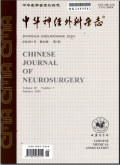超高场强磁共振深部脑刺激电极周围组织的病理改变
Pathological findings around deep brain stimulation leads in ultra-high field MRI
摘要目的 通过对比超高场强MRI(7.0T和3.0T)与高场强MRI(1.5 T)下深部脑刺激(DBS)电极周围组织的病理学变化,深入探讨射频磁场中DBS电极热效应对周围组织的影响.方法 雄性新西兰白兔18只,随机分人7.0T组(n=6),3.0T组(n=6)及高场强1.5T组(n=6).各组动物以左侧丘脑腹后核为靶点,植入全套DBS电极和刺激器.术后进行对应场强核磁共振扫描,24 h后对针道周围脑组织进行HE染色及电镜检查,并对组织损伤进行评估.所有统计结果采用均数±标准差表示,使用SPSS 19.0医学统计程序进行单向方差分析,P<0.05为差异有统计学.结果 HE染色及电镜检查显示在距针道相等距离位置,7.0T组及3.0T组的细胞损伤程度与高场强1.5T组相比,差异无统计学意义(P>0.05).结论 超高场强磁共振(3.0T及7.0T)并未造成DBS电极周围出现明显热损伤,提示体内植入DBS设备的患者进行超高场强磁共振扫描可能是安全的.
更多相关知识
abstractsObjective To determine the pathological responses in tissue around the deep brain stimulation (DBS) leads in 1.5 T,3.0 T and 7.0 T magnetic resonance imaging (MRI).Methods Eighteen male Newzealand rabbits were randomly assigned to ultra-high field 7.0 T group (n =6),ultra-high field 3.0 T group (n =6) and the routine 1.5 T group (n =6).DBS devices were implanted into the rabbit brains of each group targeting the left VPN of thalamus.MRI scanning of corresponding field strength was conducted.After 24 hours,the brains were processed for HE staining and transmission electron microscopy (TEM).The results were semiquantified using our scoring system.All data were shown as mean deviation,and processed by one-way ANOVA analysis using SPSS 19.0 software.A P value less than 0.05 was considered statistically significant.Results In HE staining and TEM,the difference between the ultra-high field groups and the routine 1.5 T group was not significant (P > 0.05).Conclusions In this study,the heating of DBS lead in ultra-high field MRI scanning failed to induce more injury than in the routine 1.5 T MRI,indicating that the ultra-high magnitude MRI scanning might not be as dangerous to the patients with DBS devices as we thought.
More相关知识
- 浏览291
- 被引2
- 下载88


相似文献
- 中文期刊
- 外文期刊
- 学位论文
- 会议论文



 换一批
换一批 换一批
换一批



